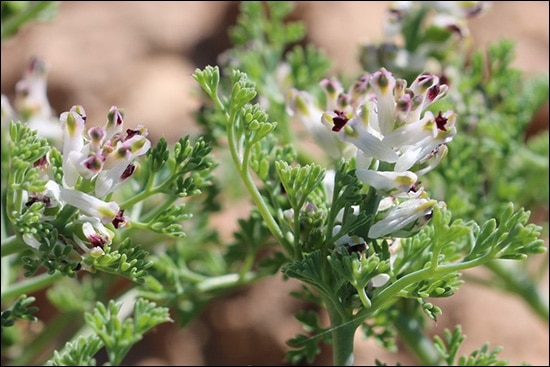Parpata (Fumaria Parviflora)- Medicinal Properties, Formulations, Dose & More...
There are many different medicinal herbs and their effects in ayurveda have been mentioned and nearly 15000 herbs have been identified and recorded. Every herb in ayurvedic texts are classified and grouped under different categories some has classified herbs on the basis of its made of action and some has classified herbs on the basis of its morphology. In this article we will be discussing an herb known as Parpata (Fumaria parviflora).

Introduction
It's an ayurvedic herb, its Sanskrit name is parpat and latin name of this herb is Fumaria parviflora. It belongs to the family of fumariaceae and English name is Acharya charak has mentioned parpat in trishna nigrahan gan that means it has been classified under the category of herbs which are thirst quenching.
Distribution
This is a type of weed which can be found all over India and neighboring countries. Mainly found near the shores of Ganges, foothills of Himalayas, and in Nilgiri.
Different Names According To Ayurveda
- Name in English - Indian fumitory
- Name in Arab - Sahtaraj
- Tamilian Name - Tura
- Name in Punjabi - Shahtara
- Name in Hindi - Pitta papada
Morphology Of Parpata
- It is a straight and erect herb having height of 7-8 cm it has herbaceous branches.
- It has a stiff , pale colored, furrowed , brownish stem
- Leaves are 1-8 cm long
- Leaves are compound and pinnately, its lamina outline is ovate and orbicular having dimensions of 1.5-5 ×1-4 cm
- Arrangements of the leaves are in racemose form
- It has 5 to 22 flowers whose peduncle has length of 0.2 -1.7 cm
- It has light pink colored flowers which are curved downward
Histology Of Parpata
- Root has a single layer of epidermis and the epidermis surrounds 5-6 layers of cortex. It also contains 1-2 layers of rectangular and thin walled parenchymatous cells.
- Central core of roots and stem has narrow phloem consisting of usual elements and it has wide xylem and having usual elements.
- Stem has a pentagonal outline which has prominent angles which are composed of collenchymatous cells.
- Vascular bundles are 5-7 in numbers arranged in a ring pattern.
Cultivation Of Parpata
- Farm lands, sunny and warm situations are favorable for the cultivation of parpata
- It grows well on loose, drained and loamy soil.
- Suitable PH of soil to grow it is 6.5 to 7.5
- It grows best in cold temperatures but it cannot withstand less than 10 degree Celsius temperature as lower temperature than 10 degree.
- It is easily grown in areas with less rainfall which have irrigation facilities.
Chemical Composition Of Parpat
It has active components like:
- Pentatriacontane alkali (0.5%)
- Tannins
- Furmaramine
- Furmaramidine
- Lahoramine
- Fumaric acid
- Fumarine
Parts Used
Whole plant can be used for medicinal purpose.
Dose
- Churna - 2-5 gm
- Decoction - 50-90 ml per day in divided dosage
- Paste - 1-3 gm
Medicinal Properties Of Parpata
- It has laghu guna (light quality)
- It has a tikta (bitter) taste
- It undergoes pungent taste conversion after the process of digestion
- It is having sheeta (cold) potency
- It balances kapha and pitta dosha and can increase vata little bit
- As it has more tikta dosha it balances kapha and due to sheeta and tikta ras it balances pitta dosha.
- It is thirst quenching herb
- Digestive
- It can act as anthelmintic
- Stimulates the liver and helps it to function properly
- It can be used in vertigo, syncope, alcoholism, etc
- Used in anorexia
- Disturbed digestion
- Jaundice
- It can treat raktapitta, gout.
- It is helpful in dysuria
- Useful in skin disorders
Some Medications Which Have Parpata
- Parpatadi Kwath
- Parpatadi Arishta
Home Remedies From Parpata
- It can be used for vomiting as in decoction form which will treat vomiting
- Decoction of crushed parpata can be used for fever
- For intrinsic bleeding parpata juice with honey can be used
- In erysipelas, parpata juice can be mixed with ghee and applied on the skin to treat this condition.
- Bleeding piles can be washed with the juice of parpata mixed with the ghee.
- In excessive thirst, water infused with the parpata is used to drink repeatedly.
- Parpata juice processed with oil can be applied on wounds or ulcers to heal it.
Conclusion
Parpata is an ayurvedic herb which is classified under the thirst quenching herbs (trishna nigrahan). It falls under the family Fumariaceae. It has a wide variety of uses like it can be used on the skin and it can be used for vomiting also. There are many home remedies where fresh parpata can be used. Also there are medications which have parpata in them and these medications can be used in combination with the herbs which decreases the pitta dosha and kapha dosha in the body which will enhance the effect of the herb.

